Support strong Canadian climate journalism for 2025
A stable climate was a beautiful thing.
It allowed civilization to develop and humanity to prosper. And it allowed all the planet’s majestic ecosystems we cherish and rely on to thrive as well.
But that’s now gone — cooked away over a few short decades by rampant fossil fuel burning. In fact, 90 per cent of all planet-heating gases humans have ever released from burning fossil fuels have been dumped into the atmosphere during the lives of the baby boomers. That’s my generation. We got to grow up under a stable climate. And we’ve spent our lifetimes helping to burn it down.
In contrast, today’s youth — and all future generations of Canadians — are finding themselves trapped in a cage match with an increasingly “angry beast.” And we keep making this climate beast ever more dangerous with each additional tonne of climate pollution we emit.
The burning question for today’s adults is how violent and unpredictable of a climate legacy are we going to saddle our children and future generations with.
Historically, Canadians have been one of the world’s top 10 climate polluters — both in total and per capita. For the last 35 years, we’ve repeatedly promised to do something about it. How are we doing?
In this article, we’ll first take a quick look at what Canadians have done so far with our oversized climate pollution. Then we’ll take a deeper dive into one of our largest and most out-of-control emissions sources that’s feeding the climate beast — our tailpipes.
Canada is leading our peers…
As the decades have rolled on and climate breakdown has grown ever more dangerous, Canadians have been out in front, leading our peers. But not in a good way.
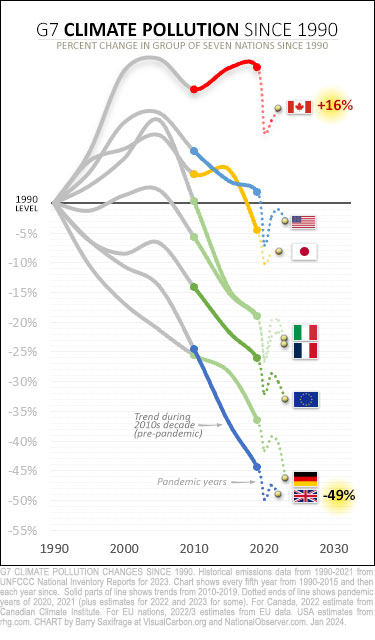
My first chart shows what Canadians — and our peers in the Group of Seven (G7) nations — have done with their climate polluting since 1990.
As you can see, every G7 nation now emits less than they did in 1990 — except Canada. We are the climate rogues in the group, still emitting far more.
Collectively, these wealthy, industrialized nations emit one-third of global climate pollution and produce half the world's GDP. These nations have the resources, talent and capacity to reduce their emissions.
And most have. For example, the chart shows that our German and British peers have been steadily reducing climate pollution for decades. As a result, they’ve cut their emissions in half.
Clearly, it has been possible for Canadians to reduce our oversized climate impact as well. We’ve just refused to act.
If we want to save our kids and future Canadian generations from a dystopian future, we have to stop fuelling the crisis. And a critical place we have to slam the brakes on is the amount of climate pollution we dump out our tailpipes.
Pumping up the climate beast.
Few sources of Canadian climate pollution are larger and more out of control than the gasoline and diesel we pump into our cars and trucks. It’s arguably our nation’s single biggest climate impact. My next chart compares the immense scale of these emissions to those from other sectors of our economy and lives.
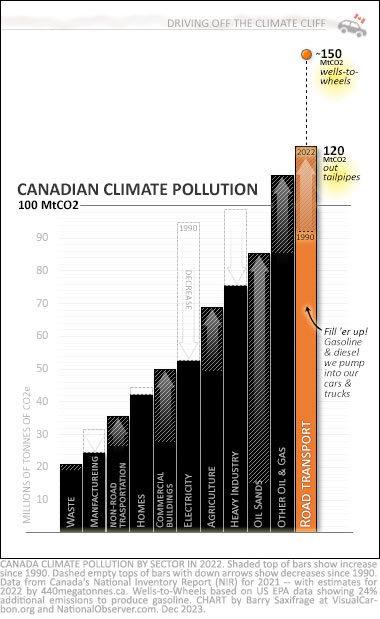
That tall orange bar on the right is tailpipe emissions from all the road vehicles in Canada — around 120 million tonnes of CO2 (MtCO2) per year.
This “pump it and dump it” climate damage rises to around 150 MtCO2 when we include the additional emissions from extracting, refining and shipping all that gasoline and diesel.
That “wells to wheels” total is shown by an orange dot on the chart, way above everything else.
For scale, there are more than 140 nations that emit less than that for everything in their economy and society.
As the chart shows, it is also more climate pollution than from major sectors in our economy — like heavy industry, agriculture, electricity or all our buildings. In fact, even Canada’s notoriously polluting oilsands industry emits less (86 MtCO2) than our tailpipes.
Not only are our tailpipe emissions massive, we’ve also been increasing them twice as fast as our overall emissions. Canadian tailpipe emissions have risen 28 per cent since 1990 — versus a 14 per cent rise for everything else combined. This surge in tailpipe pollution has erased our climate progress in other areas and dragged our national emissions even higher.
What’s driving this trend? Lots more tailpipes — attached to the world’s worst gas-guzzlers. Let’s look at each of these problems in more detail.
Problem #1: Canada’s rising horde of burners.
The primary reason our tailpipe emissions are going up is that the number of fossil fuel-burning cars and trucks (a.k.a. burnermobiles) keeps going up. My next chart shows the relentless trend.
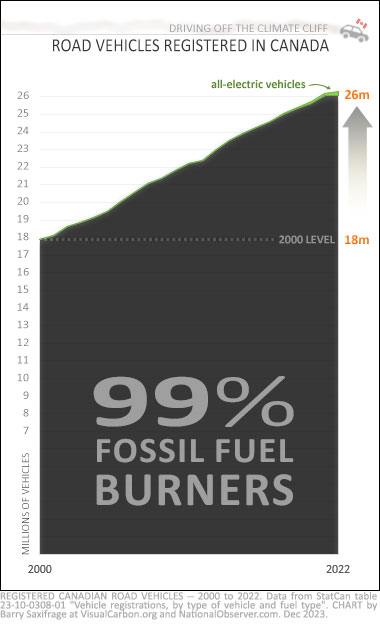
Back in 2000, we had 18 million burners on our roads. Now we have 26 million.
That means we have eight million more gas tanks we are filling. And eight million more tailpipes spewing climate pollution.
Canadians could choose pure battery electric vehicles (BEVs) instead of burnermobiles. These run on made-in-Canada electricity, which is far less climate- damaging than gasoline.
In fact, gasoline engines are about as climate dirty as you can get — producing twice the climate pollution of coal power plants to do the same work.
So far, however, less than one per cent of Canadian cars and trucks are BEVs. On the chart, they’re shown by the tiny green smear of frosting on top of that hulking black mountain of fossil burners.
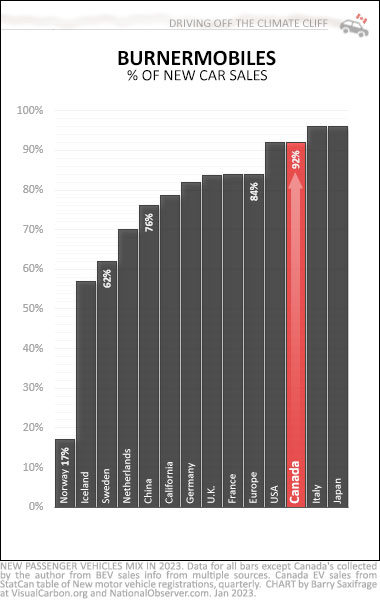
That last chart showed the trend over the last couple decades. This next one focuses on what we did last year.
The height of each bar shows the percentage of new passenger vehicles that burn gasoline or diesel.
The red bar is Canada. Last year, when Canadians decided to buy a brand-new passenger car or truck, 92 out of 100 bought a burner. That’s according to the most recent data from Statistics Canada.
As you can see, that’s a higher rate than our peers in many other nations.
For example, last year in the cold, northern, oil-producing nation of Norway, new car buyers only picked burnermobiles 17 per cent of the time. They chose all-electric BEV 83 per cent of the time. As a result, total emissions from Norway’s passenger vehicle fleet have been plunging.
New cars and trucks last a long time. As each new one rolls off the dealer’s lot, it commits us to tonnes more climate pollution spewing out its tailpipe for the next decade or two. How many tonnes are locked in depends on how big of a gas guzzler each car is.
And here again, Canadians lead the pack.
Problem #2: Canadians choose the world’s most climate-polluting cars.
A second major reason for Canada’s huge tailpipe emissions is the sad fact that Canadians choose to buy the world’s most climate-polluting new cars.
This was true a decade ago, according to a survey I covered back then by the International Energy Agency (IEA). And it’s sadly still true today, according to a new report by GlobalFuelEconomy.org.
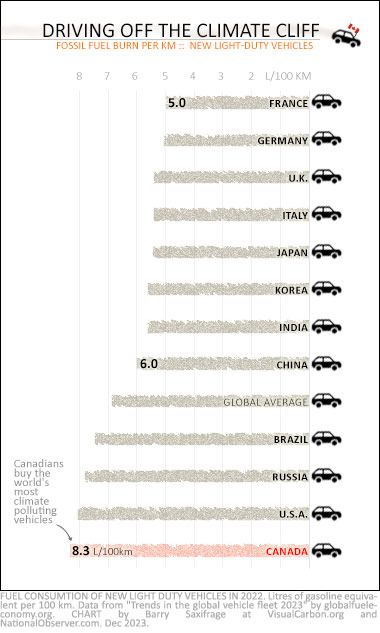
My next chart shows what this most recent report found.
Each bar on this chart shows litres burned per 100 kilometres (L/100km), for the average new passenger vehicle.
For example, at the top of the chart, we see that the French, Germans and British choose cars that burn five litres on average. In the middle of the pack, we see that the Chinese buy new cars that burn six litres on average. And the world average is a bit under seven litres.
Where are Canadians? Way down at the very bottom. Our new passenger vehicles average 8.3 L/100km.
Some common new Canadian vehicles that burn around 8.3 L/100km include the all-wheel drive versions of the Toyota RAV4 and Camry, Honda CR-V, Ford Escape and Subaru’s Impreza, Forester and Outback.
Cars and trucks last a long time and those litres add up. In Canada, the average new passenger vehicle requires the owner to pump over 20 tonnes of gasoline into it over its lifespan. At recent gas prices of around $1.50 per litre, it will cost more than $40,000 at the pump.
All that gasoline gets dumped out the tailpipe and straight into the environment as it’s burned. That will pump more than 75 tonnes of planet-heating gases into our already destabilized climate.
It is easy to appreciate the massive size and weight of our cars and trucks. But hidden from view are the vastly larger amounts of gasoline and climate pollution that come with them. They each weigh many times more than the vehicle itself.
All that future gasoline production, burning and resulting climate damage gets locked in the minute the new car or truck is purchased.
Driving off the climate cliff…
We’ve got the kids in the back seat.
Are we really going to drive them off the climate cliff?
Because that’s the direction we’re headed with our growing horde of the world’s most climate-damaging vehicles.
If we want to give our kids and future Canadians a fighting chance at a decent future, we'd better reverse course quickly — while there is still time.
---------------------------------
ENDNOTES
Related articles
Interested in even more info on the climate impact of Canadian cars and trucks? Here are a few more of my articles on this topic:






Comments
It would be interesting to see data on the number of pick-up trucks in Canada relative to other countries. These vehicles are enormous, get bigger with each model year, and always seem to be in ready supply at dealerships, unlike more fuel efficient vehicles. The automobile industry in North America needs to be more regulated since these monster trucks are not only an environmental disaster but a safety issue.
First thing to do, ban all publicity for gas guzzling vehicles. Last Friday night, I was watching The Fifth Estate on CBC, "Boiling Point: Climate Chaos". During the one hour program, I probably saw 10 or more publicity on gas guzzling SUVs and pickup trucks driving through nature devastating everything in their path.
It is quite shocking to see CBC programming a show on climate change and showing at the same time publicity of products largely responsible for the problem. Unfortunately, it happens all the time even with companies promoting new versions of electric SUVs and pickup trucks.
Why don't they show these vehicles stuck in traffic instead, or the damages that they are causing in a traffic accident (because they are getting heavier and heavier all the time, they are causing more damages and killing more people). We should follow some European cities, like Paris, where the citizens have voted to triple the parking fees for SUVs. In some places, they just want to ban them from downtown.
Complain to CBC. Complain to the ad agency. Complain to the company.
Complain to your MP, copy in ministers and critics, and the Office of the PM -- no harm including other party leaders too. It all costs the same!
If more people complained, there'd be less of that particular kind of advertising.
The ads that particularly galled me were during the summer Olympics, with a voice track that said, in effect, water's a wonderful thing, but only after we enclose it in pools (or, presumably, otherwise make it impossible for anything to live in).
Admittedly, it does get harder and harder to complain, with phones answered by machines that simply pass one on to recorded messages, e-mail that's not even acknowledged, and letters that are never answered.
Remember that letters to the federal government ride postage-free.
Thank you Barry. That was illuminating and hard hitting. May the article find legs and be shared widely.
I can't help but be reminded of the thickness of his thought when the slogan ranting PM wannabe said something to the effect that all Canadians want to be able to do is hunt with their rifles and drive their trucks. “It’s (the Liberals) punished them for heating their homes, driving their trucks, and eating food from grocery stores. They’re also banning hunting rifles...." P.P., Sept. 15/23
And P.P.'s CPC leads in the polls. Axing the tax will only encourage more gas to be burned in Canada and be a financial windfall for the fossil fuel companies which the Conservative Party of Canada (CPC) is in lock step with.
PP is Canada's trump but without the dementia. His popularity really scares me.
If the federal government is going to subsidize the purchase of electric buses, maybe it should put part of that subsidy into using the sides of buses to warn the public about climate change. Airports might also be a good place to do this. Somehow the public needs to be convinced that sacrifices are necessary.
$40K on gas over lifetime of car seems like a lot. Also a lot of taxes for folks who don’t like paying those. A battery EV would save about $20K. For people with understandable range anxiety, plug-in hybrids might be the way to go—they plug in for everyday use, but have a gas tank for backup. There has been reasonable concern about the lower efficiency of EVs in the cold, but regular vehicles also burn more fuel in the cold. Except that’s becoming less of a problem now with winter going away.
I support EVs but the charging networks need to be more accessible. They all require one to have an "app" or membership card. You can't just pull up to any charger and use a credit card and be on your way again.
About EV charging networks. It really irks me that charging networks require users to have an "app" or membership card to use their chargers. A credit or debit card works in any gas pump. You don't need an "app" for every gas station chain, why should an EV charger not work the same way?
The app allows you to see how many chargers are available at particular locations and book ahead. In some cases it will allow you to reserve charger-equipped parking spots at work and be able to sell power to the grid at much higher daytime rates after charging at home during the wee hours when rates are a bargain. The difference is credited to your electrical bill.
But most EV owners won't be using the app because they'll be charging at home at night at a fraction of the cost of gasoline. Most EVs today have a range that averages 300 km, with variations for cold winters...which doesn't really matter when the battery pack is nice 'n warm in a garage.
Then there are those of us who live in walkable neighbourhoods where we don't need to drive much at all. Car ownership there, EV or not, is optional.
The fraction, of course, depends on the local cost of electricity. In Ontario, we've paid (and continue to pay) so much for nuclear power stations, that we pay through the nose for electricity.
The "electricity rates" and the cost to consumers are entirely separate kettles of fish. Added to the *rate* are per-customer costs, maintenance costs, wastage costs (company wastage, not consumers', at ~3%), "delivery" charges, cost of new build-outs absorbed by "the system", and last but not least, profits to (preferred) shareholders and a 9% overall profit for the local utility. While the "electricity rates" charged are 10.3 cents/kwh (lowest tiered rate for under 400 kwh/mo) the net cost to me is 32.4 cents/kwh. Because so much of the bill is not dependent upon usage, the less I use, the more it costs me per kwh.
Businesses that use higher volumes also pay lower rates than those consuming less.
On top of that, residential users subsidize business use.
And for the most part, the Big Polluters, because of arrangements with government, enjoy highly (or even fully) subsizied electricity, artificially lowering the cost of their goods to consumers.
This is a really good introduction to the problem, but without much of anything about effective solutions (except the usual mention of electric cars). Maybe time for some real focus on what needs to be done, with good current examples? I have a few op-eds in the National Observer like this one from 2019 https://www.nationalobserver.com/2019/05/18/opinion/green-new-deal-must… But ongoing reporting needed.
According to research made in the UK, "Car Tyres Produce Vastly More Particles Pollution Than Exhausts, Test Shows" (The Guardian, Fri June 03, 2022). Toxic particles from tyre wear were estimated to be almost 2,000 times worse than particles from car exhausts, and even higher as the weight of the vehicle increases.
Tests reveal that tyres produce more than 1tn (trillion) ultrafine particles for each kilometre driven, meaning particles smaller than 23 nanometres. These are also emitted from exhausts and are an area of special concern to health, as their size means they can enter organs via the bloodstream.
These tyre particles pollute air, water and soil. They contain a wide range of toxic organic compounds including known carcinogens. A particular chemical found in tyres, called 6PPD, has been identified in USA and Canada as being responsible for the death of salmon in rivers and streams.
It doesn't matter what kind of car (or truck) you drive, the problem is that there are to many cars on the roads. Listening to the news these days, it seems that governments, police and people are more interested in solving the "stolen cars" problem and fighting the carbon tax than taking care of people's health. That says a lot about the "car culture" in our world.
Yaaaay Barry, another excellent, thorough but criminally, consistently BURIED perspective along with its emotionally devastating reminder of what we have already SO stupidly, SO carelessly driven RIGHT over top of--the bubbling, shining wellspring of our very existence.
Since this is further proof that conservatives truly could kill us all. Seriously. So it's THEM that need to be buried, and yesterday.
How to do that? The only useful thing they have provided under the dire circumstances at hand is JUST how effective an emotionally driven and relentless laser-focus can actually BE in burying the actual burning issues. And since there's SO much untapped emotion around what's happening to the climate/environment among progressives, emotion that's currently focused instead on identity politics and virtue signalling in a wave of milquetoast church-lady hand-wringing. Valid though some of those issues are, where's our much-vaunted progressive perspective when we need it most?
This article should be the call to arms needed to wrest control over the emotional levers with a laser focus on the truth nestled in our breaking hearts. It's the only way to establish the war footing.
Excellent article that lays out the case for changing Canada's car culture really well.
One cricitism: it's disingenuous to claim vehicles are our biggest polluter while splitting fossil fuel industries into 2 parts (tar sands & others) as the 2nd and 3rd biggest. Together they dwarf every other one including transportation. It's a pretty shameless misuse of statistics.
But that doesn't take away from the importance of controlling our vehicle emissions including shifting to smaller vehicles and to evs.
The government's ev mandates will help enormously along with improving the charging network. We just bought a Bolt bev and it took a year to get it while American dealers have their lots full of them - manufacturers need to be challenged/pressured to serve the Canadian ev market better. Regulating advertising would also help.
If Poilievre wins all the existing and potential steps to change this situation will go out the window.
A Poilievre win will be a disaster for Canada from several angles, not just in the energy and climate fighting fields.
But it won't stop the insidious demand destruction for oil sands products in Alberta's export markets as EVs and renewables continue down the parh of outcompeting carbon fuels on price.
Perhaps the most important but yet to be widely elucidated benefit of EVs is the rocketing advances in battery tech. The stable chemistries evolving today in several countries have already appeared in massive scales on the grid and are key to erasing the daily peaks and valleys of intermittentcy in renewables, like solar and wind.
Where short-term storage of lithium chemistries from the EV industry gives way to longer duration storage in some flow batteries and other evolving materials combinations, putting grid battery storage and renewables at a competitive advantage over fossil fuels.
Arguably, EV battery tech boosted the overall move to societal scale electrification using zero emission sources of power. That is a heavenly marraige.
I’m a huge fan of Barry Saxifrage’s hard-hitting climate charts but … the implication running through this piece is that individual choice is both the key underlying cause of the transportation emission problem and the main solution. But we know this is not true. Our individual choices are limited by vehicle producer production decisions and how they manipulate customer preferences via advertising. That and the absurd under-development of alternatives that real everyday people need - like affordable and convenient forms of public mass transit. I’d love to see Saxifrage take on the carbon-intensity of the trucks ads, for example, consciously and effectively aimed at manipulating generation after generation of male vehicle consumers. Demand is “manufactured”, manipulated and shaped and doesn’t simply appear out of thin air. While individual choice plays a role in the burnermobile problem burnerproducers and the choices they make are far more important.